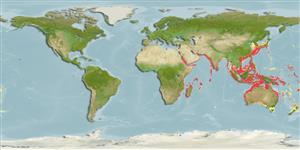Common names from other countries
Classification / Names / Names
Common names | Synonyms | Catalog of Fishes (gen., sp.) | ITIS | CoL | WoRMS
Environment: milieu / climate zone / depth range / distribution range
Ecology
Benthic; depth range 60 - 399 m (Ref. 78901), usually 60 - 200 m (Ref. 76930). Tropical
Indo-West Pacific: Red Sea to Japan, Philippines and Indonesia. Pérez Farfante (Ref. 75620) recognizes 3 subspecies: Parapenaeus fissuroides fissuroides from Indonesia to Japan and the Philippines, Parapenaeus fissuroides erythraeus from the Red Sea and Parapenaeus fissuroides indicus from east Africa and Madagascar.
Length at first maturity / Size / Weight / Age
Maturity: Lm ? range ? - ? cm Max length : 2.7 cm CL male/unsexed; (Ref. 119007); 3.61 cm CL (female)
Found in high salinity and high temperature areas (Ref. 76930).
Life cycle and mating behavior
Maturity | Reproduction | Spawning | Eggs | Fecundity | Larvae
Members of the order Decapoda are mostly gonochoric. Mating behavior: Precopulatory courtship ritual is common (through olfactory and tactile cues); usually indirect sperm transfer.
Pérez Farfante, I. and B. Kensley. 1997. (Ref. 75620)
IUCN Red List Status (Ref. 130435)
CITES status (Ref. 108899)
Not Evaluated
Not Evaluated
Human uses
| FishSource |
Tools
Internet sources
Estimates based on models
Resilience
High, minimum population doubling time less than 15 months (K=0.94-1.01; tm=1).
